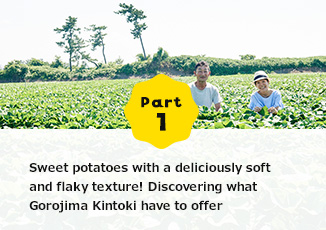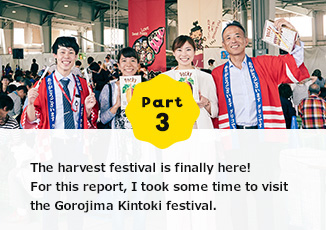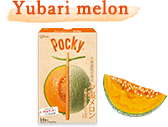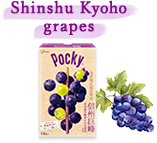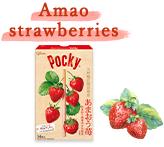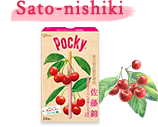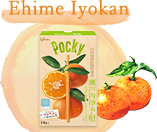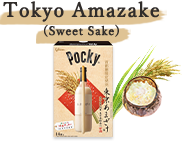Have you heard of Kanazawa’s Gorojima Kintoki Sweet Potatoes before?
It is growing up at the sand dunes.
Kanazawa is popular for its traditional culture and delicious cuisine, with a range of unique Kaga vegetables being used to produce unique and seasonal arrangements. Once such item is the Gorojima Kintoki Sweet Potato, a sweet potato local to Kanazawa. There are vast fields of these potatoes fanning out beneath the clear blue skies. In the distance are beautiful mountainous landscapes...but the truth is, Gorojima is an area of sand dunes. Why on earth grow sweet potatoes in Kanazawa, of all places? And why on sand dunes? In this first installment, we delve into the backstory of this unique item and some delicious ways to try it. Our guides on this tour are Tetsuro Nishizawa and Tetsuji Tadamura, members of the local Gorojima Sweet Potato Committee.
The savior of the dunes, dating back to Satsuma domain!
Gorojima Kintoki Sweet Potato got its start about 300 years ago. In the Edo period (1603-1868), a man named Taroemon brought sweet potatoes from Kagoshima to Kanazawa and planted them here. Given its terrain of sand dunes, Gorojima was not suited to collecting water in fields, meaning produce could not be properly cultivated. No matter how hard anyone tried, they could not get a crop to last. Seemingly out of nowhere, the mysterious sweet potatoes from Kagoshima grew with ease -- they were perfectly suited to the sandy soil! This became a valuable source of sustenance for the locals, with each generation of farmers successively trying different techniques to improve upon the crop. Today, these sweet potatoes are a recognized brand-name item nationwide.
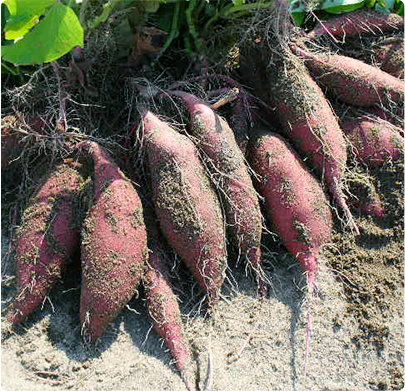
Developing “kobbo kobo†sweet potatoes
In the Ishikawa dialect, “kobbo kobo†refers to a soft and flaxy texture, particularly when talking about potatoes.
Their goal was neither a chewy, sticky potato, nor a gigantic tuber. What they sought was a “kobbo kobo†potato with a dense and flaky texture.
One hint they discovered was in the sand granules of the dunes of Gorojima. The coarse sand granules that flowed in from the soil pushed through the Tedorigawa River would sink into the estuary, break down, and drift farther away. The ones around Gorojima were medium in size, with a good balance of porosity and water retention. The farmers found that this sand was ideal for cultivating the fluffy, flaxy potatoes they sought.
The soil must also be cared for properly; the fields are only fertilized once before the harvest, with no additional fertilizer added. While this reduces the crop yield, it produces the flaky potatoes they want. Another key point is the unique rice bran used as fertilizer. This bran enhances the sweetness of the crop and also helps curb the spread of harmful bacteria.


What are the best ways to enjoy sweet potatoes?
Gorojima Kintoki Sweet Potatoes are neatly subdivided into thirty-nine categories before shipment. They range from ones the size of a fist to ones as thin as a thumb. This allows the customer to select the right size for their dish.
I asked what shape of potato tasted best. “Well, if we had our druthers,†they said with a smile, “a slender potato is best.â€
A handsome, svelte Gorojima Kintoki Sweet Potato apparently has the best, flakiest texture.
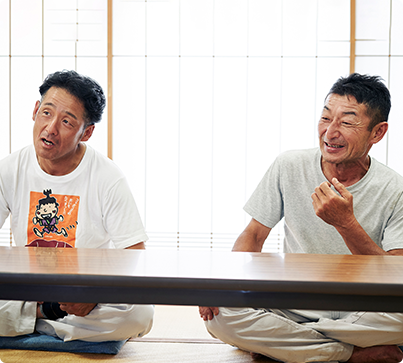 Tetsuji Sadamura (left) and Tetsuro Nishizawa (right) of the Gorojima Kintoki Sweet Potato Committee.
Tetsuji Sadamura (left) and Tetsuro Nishizawa (right) of the Gorojima Kintoki Sweet Potato Committee.
The locals like to eat the potatoes baked, in rice gruel, as tempura, in croquettes, in pork broth, in curry, in stew, and in thick potage soup. Since the potatoes are relatively dry, they hold their shape and won’t break down when stewed, so they are perfect for stewed dishes. But when it comes down to it, everyone loves baked potatoes best!
Mr. Sadamura said, “If you try them baked, you will unmistakably tell the difference.â€
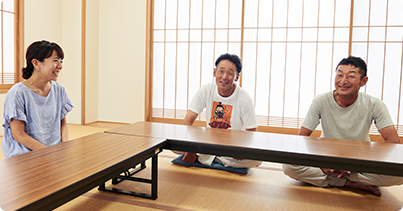
Farmers work busily all year round, getting up early to till the fields and grow delicious potatoes. We spoke with Tetsuro Nishizawa of the Sweet Potato Committee to learn about his day-to-day life as a farmer.
He has spent thirty years in Gorojima Kintoki Sweet Potato production, having been born into a farming family dedicated to these potatoes. His father passed away relatively young in life, and he and his mother continue the family farm. He gets up every day at 3:00 AM. He goes to look at the sweet potato and watermelon fields and holds meetings with local farmers (he is also the chair of the local Watermelon Committee!), working busily until evening. “Another tired country bumpkin, reporting for duty!†he says with a grin. But he gets visibly animated when talking about Gorojima Kintoki Sweet Potato.
Dreams of musicianship in youth
I asked him if he hesitated to take on the family business, or whether he had some internal conflict about it. He graciously told me a little anecdote from the past.
While Mr. Nishizawa is today a veteran farmer, in his high school days, he was a self-professed slacker, and his mother worried he would be unfit to make it to college.
His homeroom teacher told him that, since he came from a farming family, if Mr. Nishizawa agreed to go to agricultural college, he would write him a recommendation letter that would make him a shoo-in. In spite of goofing off the most out of his classmates, his career was confirmed ahead of the rest. While he developed a bad reputation in class, he now looks back on those days fondly.
He says that he and his friends even formed a band and had a go at being musicians. His parents told him that if he really wanted to be in a band, farm work would give him a lot of free time on his hands in between harvests. He took that message to heart and got to work on the farm. He soon realized it was hard work, with scarcely enough time to be in a band, let alone other things. But by going with the flow, Mr. Nishizawa soon found himself in the thick of it -- he was a farmer. (His voice, by the way, was really nice -- you could tell he was a former amateur musician.)


The present as an extension of the past
“I used to help out on the farm during vacations from school. I wound up simply doing that, only every day. It’s only a shade of difference. It was instantly familiar to me.â€
Since he had always helped out on the family farm, harvesting sweet potatoes felt like nothing out of the ordinary to Mr. Nishizawa. It was familiar territory to him. They would set up a cooking stove in the barn and put the potatoes on top to grill. When the neighbors passed by and had a bite, they raved about them. Those warm exchanges were an everyday part of life. Yet Mr. Nishizawa continues to find the sweet potatoes a thing of deep intrigue, as you never quite know how they turn out until you dig them up. Using the inherent farming knowledge he has had since childhood, Mr. Nishizawa continues his pursuit of delicious and flaky sweet potatoes today.

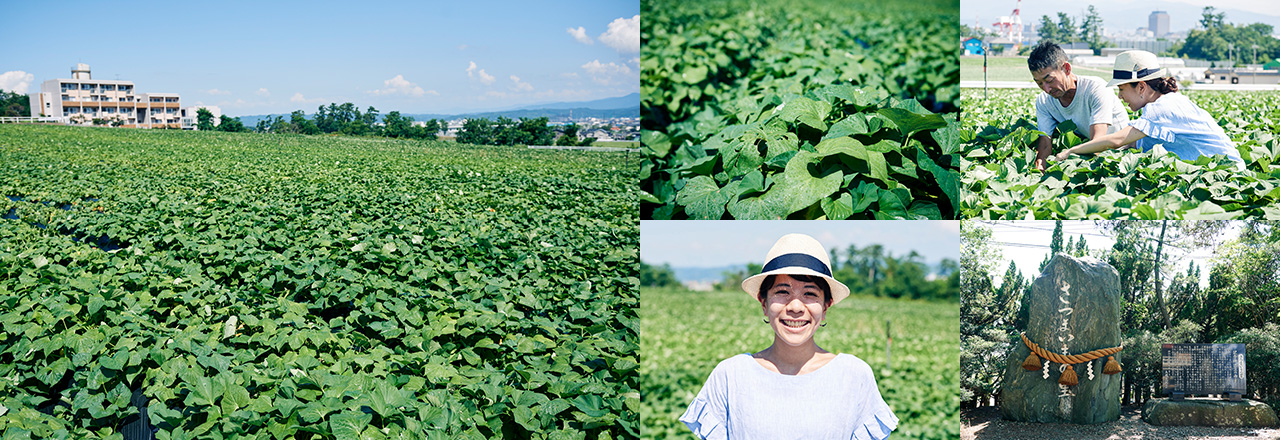
Preparing the fields
The fields are tilled and cultivated around March. Unlike other areas, Gorojima Kintoki Sweet Potato uses just one round of fertilizer! They seldom add another layer later. By contrast, they employ other strategies like using rice bran to lengthen the fertilizing.

Submersion
Sprinklers are used every two days in summer for a period of two hours to douse the crop. On days of continuous sun cover, the sprinklers are run every day.
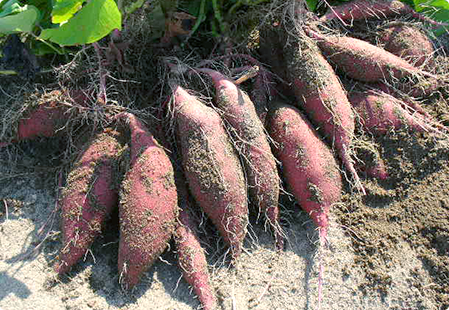
Harvest
The first harvest begins in late August, with the entirety collected by early November. When the leaves turn slightly yellowish, it is time to begin the harvest. The resulting crop is hand-sorted into thirty-nine categories.
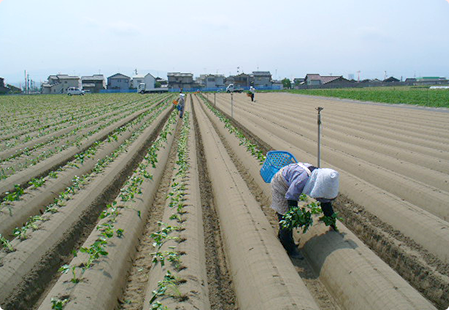
Planting
Around May, the seedlings are planted. At this time, the weeds are taken care of, the crops watered as needed, and the core cultivation begins.
Pest control
Gorojima Kintoki Sweet Potato is a relatively hands-off crop, but proper measures must be taken to protect it from harmful pests that might eat the potatoes or leaves. When first fertilizing the field and then again in late July, the entire crop is scrubbed of pests.

Can sweet potato leaves be eaten?
You usually only see the potato itself in dishes. Actually, you can parboil the stalks and eat those! Some farmers even like to specially select and grow the stalks. Apparently, even farmers seldom eat these stalks, but they have a taste resembling sweet coltsfoot and can be preserved in soy or pickled.
Three warehouses in cool Kanazawa where sweet potatoes are kept fresh and tasty
Gorojima Kintoki Sweet Potatoes are on the market year round. Kanazawa is a cool location. Part of the secret to the sweet potatoes’ taste is not only in how they are grown, but in three storage techniques. Potatoes shipped year-round are stored in warehouses that are not temperature controlled. Those destined for shipment between January and March are stored at a controlled temperature below 13 degrees Celsius. The ones that go to market in spring are stored in a curing facility.
We were given the opportunity to tour these essential curing facilities. During the harvest, this vast warehouse gets crammed to the gills full of boxes bearing potatoes!

The secret to its flavor!
What are the benefits to “curing?â€
Curing is not something we hear talked about every day. Just what is the curing process all about, and how does it preserve the flavor for sweet potatoes shipped in spring?
First, the potatoes are stored in a warehouse right after picking, and the ambient temperature is raised to between 34-35 degrees Celsius. The humidity is also raised to 100%, and they are allowed to cure for 100 hours. Then, the temperature is rapidly dropped to 13 degrees Celsius and the humidity to 80%. This curing creates a dead “cork†cell membrane layer on the surface of the sweet potatoes. The cork blocks the spread of bacteria by tricking them into thinking that the potatoes have withered away. This makes the potatoes sweeter, and they retain their flavor for longer.

From Kanazawa to Japan! A sweet potato growing region puts its name on the map
“In the old days, we used to dig the potatoes out by hand. Pure manual labor. We would then gather at the end of the day and be completely exhausted. We would pile the potatoes high, eleven stories up. Now we have machines to automate the entire process, so it’s quite a breeze,†says Mr. Nishizawa.
Today, sweet potato farmers from all across Japan come to tour the curing facilities here. Thanks to this innovative curing facility, even cool Kanazawa can continue shipping sweet potatoes year-round and bring these delicious, flaky delicacies to people around the country.



Gorojima Kintoki Sweet Potato, grown with care
In pursuit of fluffy and flaky potatoes!
From baked potatoes, to candied potatoes, to potatoes over rice, to potato tarts...sweet potatoes are one of my favorites. I’m now researching new recipes using Gorojima Kintoki Sweet Potato!













